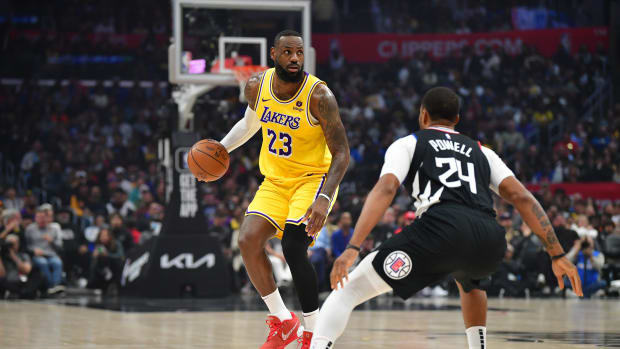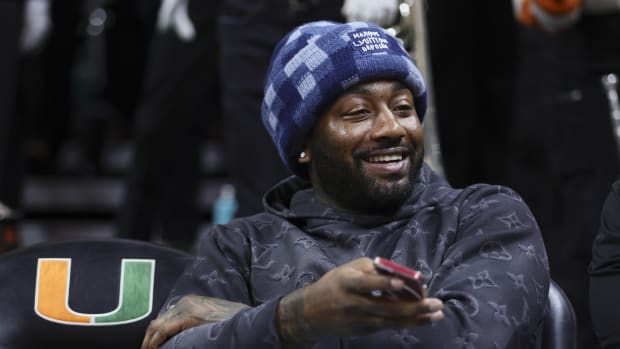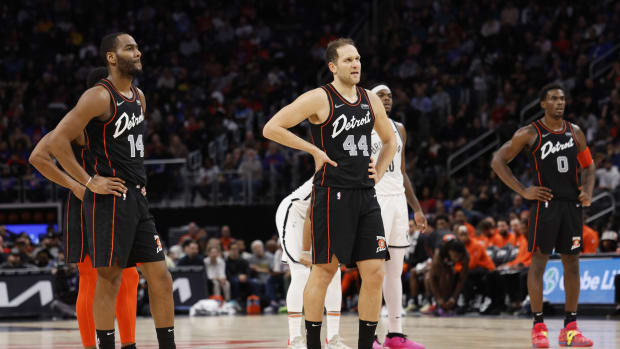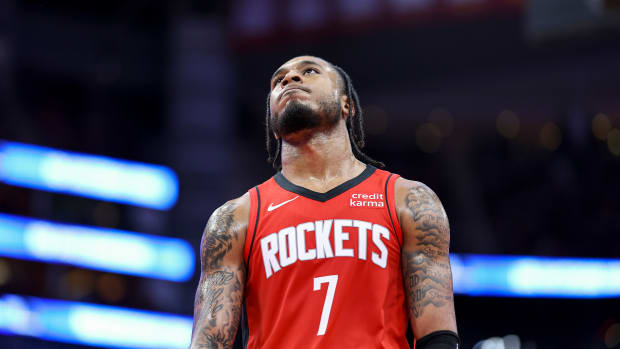How Michael Jordan Could Become Connected to Zion Williamson's Lawsuit
Zion Williamson signing a lucrative shoe deal with Jordan Brand is a major step in his budding NBA career. It is also a significant development in the New Orleans Pelicans forward’s ongoing litigation with Gina Ford, the president of Prime Sports Marketing, and it could create complications for Michael Jordan, too.
As explained in accompanying Sports Illustrated stories, Williamson has sued Ford in the U.S. District Court for the Middle District of North Carolina. Ford, meanwhile, has sued Williamson, along with CAA, for $100 million in Miami-Dade County Circuit.
The two lawsuits essentially center on one question: Is Ford owed compensation for her representation of Williamson or for Williamson terminating his contract with Prime Sports? If the answer is “yes,” how much money does Williamson owe Ford?
Keys to the litigation between Williamson, CAA and Prime Sports
There is no dispute that Williamson signed a five-year contract with Prime Sports on April 20. This was five days after the Duke freshman had declared for the 2019 NBA Draft. The contract, dubbed “Consulting and Joint Marketing and Branding Agreement”, contemplated Ford serving as Williamson’s “global marketing agent”—a title that made Ford Williamson’s exclusive representative for endorsement deals.
Under the contract, Ford would introduce Williamson to endorsement opportunities, analyze different offers and then negotiate and draft contracts on his behalf. In exchange, Williamson agreed to pay Prime Sports a 15% commission. The contract also restricted how either side could end the deal. Any termination required a 30-day notice. Also, neither party could sever their arrangement unless the move was justified by “cause.” Although not defined in the contract, “cause” normally refers to a finding that the other contracting party violated the agreement or otherwise broke the law in a way that undermined the agreement.
Ford contends that she engaged in numerous negotiations and deal-making sessions on behalf of Williamson. For instance, she asserts that she and Williamson met with an unnamed “shoe/sneaker company” on April 28, and that Ford arranged for this meeting to occur. According to legal documents filed by Ford’s attorney, Stephen Drummond of the New York-based law firm Drummond & Squillace, the meeting centered on a prospective shoe deal that contemplated $100 million in payments to Williamson. Ford also claims to have engaged in negotiations and/or discussions with such companies as Puma, Activision Publishing (Call of Duty video game); EA Sports (NBA Live); 2K Sports (NBA 2K); General Mills (Wheaties), Beats by Dre, Chase Bank, Harper Collins, Monster Hydro, Burger King, Mercedes Benz, T-Mobile, Kraft Heinz, Powerade (Coca-Cola) and Biosteel.
By the end of May, Williamson would cut ties with Ford and hire CAA as his agent for both his employment and endorsement contracts. In filings drafted by Jeffrey Klein of the New York-based law firm Weil, Gotshal & Manges, Williamson asserts that his contract with Ford is unenforceable under North Carolina’s Uniform Athlete Agent Act (UAAA). This law requires that persons who represent college athletes comply with a bevy of requirements aimed at reducing opportunities for college athletes to unwittingly forfeit NCAA eligibility. To that end, the UAAA compels agents, including those retained for endorsement deals, to ensure that a representation contract contain written warnings about the impact of the player signing a contract on his or her NCAA eligibility. No such warnings were present in the contract Williamson signed with Prime Sports. Williamson thus argues that his contract was invalid.
Both sides, then, are armed with logical legal arguments. Ford can credibly argue that Williamson violated the contract he signed with her and that she performed meaningful—and perhaps compensatory-worthy—services on his behalf. Williamson, in turn, can credibly argue the contract he signed with Williamson might not have been enforceable. This dynamic suggests that the litigation could take time to play out. That is particularly the case since two courts are now hearing the dispute (and applying different states’ laws, as well).
How Jordan Brand could connect to the litigation
Enter Williamson’s endorsement deal with Jordan Brand.
Last week, Williamson signed a five-year deal with Jordan Brand reportedly worth $75 million. The deal, as explained by Sports Illustrated’s Jarrel Harris, is the richest ever for an NBA rookie.
If Ford played any role in the formation of this particular deal—for example, if she had meetings, phone calls, emails or text conversations with representatives from Jordan Brand—the Jordan Brand signing is very relevant to the litigation. The same would be true of any other endorsement deal that Williamson signs, including his new agreement with 2K.
Typically, agents are not owed compensation unless and until they sign the athlete to a contract. At that point, agents are owed a commission. The law is less clear if multiple agents had performed work at different stages on an eventual contract. If Ford played a meaningful role in Williamson landing with Jordan Brand, she’ll argue that she—rather than, or in addition to, CAA—is owed a commission.
For that reason, it’s possible that Ford could seek to compel Jordan Brand into her litigation against Williamson. This could occur in the form of depositions of Jordan Brand officials and related discovery requests, or perhaps by adding Jordan Brand as a co-defendant on the theory that the company owes Prime Sports the value of the commission.
It’s possible that in contemplating this type of scenario, Jordan Brand demanded an indemnification clause from Williamson. Such a clause would say, in so many words, that if Williamson’s litigation with Ford drags Jordan Brand into legal proceedings, Williamson would indemnify Jordan Brand for any associated costs or damages.
Still, an indemnification clause wouldn’t foreclose the possibility of Jordan Brand officials being subpoenaed to provide sworn statements and share electronic communications. Ford could argue that her lost earnings are very much connected to Williamson’s deal with Jordan Brand, an argument that (as noted above) would be bolstered if Ford had communications with Jordan Brand before Williamson dropped her for CAA.
Michael Jordan also has reason to monitor the litigation
As the governor of an NBA franchise and the “Greatest Of All Time” in the sport of basketball, Michael Jordan is undoubtedly a busy person. However, he might be keeping close tabs on the Williamson-Ford dispute. Depending on whether Jordan played any role in Williamson signing with Jordan Brand, the 56-year-old billionaire could become a relevant party in the litigation.
To be clear, Jordan does not own Jordan Brand. According to Nike’s public statements and U.S. Securities and Exchange Commission filings, Nike owns it. Jordan Brand is one of nine categories of Nike’s product offerings: Running, Nike Basketball, the Jordan Brand, Football, Men’s Training, Women’s Training, Action Sports, Sportswear and Golf.
Nike has also aggressively defended the intellectual property associated with Jordan Brand and, by extension, Jordan the player. Earlier this year, the U.S. Supreme Court declined to review a 2018 ruling by the U.S. Court of Appeals for the Ninth Circuit in a copyright case brought by professional photographer Jacobus Rentmeester. Back in 1984, Rentmeester took a photo of Jordan gliding in the air towards the hoop. Jordan was a student at UNC at the time and the photo was for publication in Life Magazine. Nike later marketed a similar photo with Jordan wearing Chicago Bulls apparel and the Chicago skyline in the background. Nike also used that image to design the famous Jumpman logo. While Rentmeester insisted that Nike had engaged in unlawful appropriation, the courts ruled in Nike’s favor due to differences between the two images.
Although Jordan Brand isn’t owned by Jordan, Jordan has made public statements indicating that he nonetheless plays a persuasive role in the brand’s decision-making. In 2015, he is quoted as telling the Chinese news outlet Xinhua that he is very involved with the management of intellectual property associated with his identity. “Anything that has my name on it,” the Charlotte Hornets governor explained, “I'll always have the proof of rights, design in terms of how it's going to be utilized, how it's going to be received. That's something I totally value when we talk about the whole Jordan persona. I want to be able to have input on everything utilized my name and my likeness. This is not something I'm just doing now, it's something I've been doing for sometimes and I enjoyed doing it and I'll continue doing it as long as I'm able to.”
The details of Jordan’s legal relationship with Nike, a publicly-traded but nonetheless private company, are not public. However, Jordan is presumably compensated in some way for Nike’s continued use of his intellectual property. Based on his own words, Jordan also appears to play an advisory or consulting role of some influence.
Jordan’s statement in response to Jordan Brand signing Williamson further highlights his continued involvement with the brand. Nike’s press release announcing the signing of Williamson includes a comment by Jordan: “Zion’s incredible determination character and play are inspiring. He’s an essential part of the new talent that will help lead the brand into the future. He told us he would ‘shock the world,’ and asked us to believe him. We do.”
Notice that Jordan’s comment references Williamson’s discussions with Jordan Brand—“[Williamson] told us . . . and asked us.” It’s clear from Jordan’s choice of words, particularly his use of the pronoun “us,” that he is still very much part of Jordan Brand.
Williamson, for his part, also explicitly mentions Jordan as a key reason why he signed with Jordan Brand. “Since I was a kid,” Williamson is quoted as saying, “I dreamed of making it to the league and having the type of impact on the game Michael Jordan had and continues to have today.” The idea that Williamson would look up to Jordan is hardly surprising. Williamson hopes to follow in the legendary footsteps that link Jordan to Kobe Bryant to LeBron James. Further, Jordan Brand has a relatively small and exclusive NBA player client list that includes such as stars Russell Westbrook, Jimmy Butler, Chris Paul and Blake Griffin.
Whether Jordan himself discussed Jordan Brand with Williamson or Ford in the context of any recruitment efforts is unknown. Through pretrial discovery Ford might be able to gain insight on that possibility.
As the NBA pledges to crack down on tampering, the league might also monitor the litigation
Jordan’s role is complicated by another factor: he is governor of the Hornets. Jordan is thus subject to the Article 35A of the NBA constitution. Article 35A is the provision of the constitution that forbids tampering by coaches, general managers and governors. Tampering, as defined by Article 35A, refers to any attempt to entice, induce or persuade a person who is under contract with another team to join the tampering team. Tampering is a topic that has attracted considerable attention in recent weeks given that officials of numerous teams clearly violated the rule as the start of free agency neared. NBA commissioner Adam Silver recently pledged to evaluate new policies that would diminish opportunities for tampering and perhaps elevate penalties for offenders.
The idea that Jordan could recruit a player to Jordan Brand does not mean that he tampered in his capacity with the Hornets. The Jordan Brand is mainly, if not almost entirely, associated with Jordan the GOAT—the former Bulls and later Washington Wizards star who inspired a popular line of sneakers and sports apparel. To a much lesser extent, Jordan Brand might also reflect Jordan’s celebrity from his other noteworthy ventures, including periodic film work (such as Space Jam), presence in video games (such as Jordan v. Bird: One on One) and even other athletic experiences (more Jordan the golfer than Jordan the baseball player).
It seems unlikely that Jordan Brand is associated much with Michael Jordan the governor of the Hornets. Jordan has been the Hornets’ governor since March 2010. The team has only qualified for the playoffs three times during that period. Charlotte’s regular season record since the ’10-’11 season (Jordan’s first full season as governor) is 297-425, a winning percentage of just .411. During that time, the Hornets have also struggled to sign major free agents and keep marquee players. One exception was the team re-signing Nicolas Batum to a five-year, $120 million deal in 2016, but Batum has underwhelmed since. It doesn’t seem that Jordan’s connection to Jordan Brand has given the Hornets a competitive edge.
On the other hand, the Hornets wear Jordan Brand apparel. Also, a significant percentage of Jordan Brand players have played for the Hornets. According to one list, there are 18 NBA players signed to Jordan Brand. Of those, six have donned Charlotte uniforms—D.J. Augustin, Bismack Biyombo, Dwayne Bacon, Michael Kidd-Gilchrist, Kemba Walker and Cody Zeller.
None of this, of course, proves that Jordan engaged in tampering. However, as the NBA appears committed to taking tampering seriously, it’s worth noting how tampering-like practices can surface in non-obvious contexts (including when Los Angeles Clippers coach and former TV broadcaster Doc Rivers appeared on ESPN in May and compared soon-to-be free agent Kawhi Leonard to Jordan). If the Williamson litigation plays out in a way that requires Jordan’s involvement, Jordan could be asked all sorts of questions about his involvement in Jordan Brand. He’d need to be mindful of the far-reaching impact of his answers.
Odds are the Williamson litigation will end in a settlement. Still, until then, it presents a case that has ties to different corners of the NBA.
Michael McCann is SI’s Legal Analyst. He is also an attorney and Director of the Sports and Entertainment Law Institute at the University of New Hampshire Franklin Pierce School of Law.





































